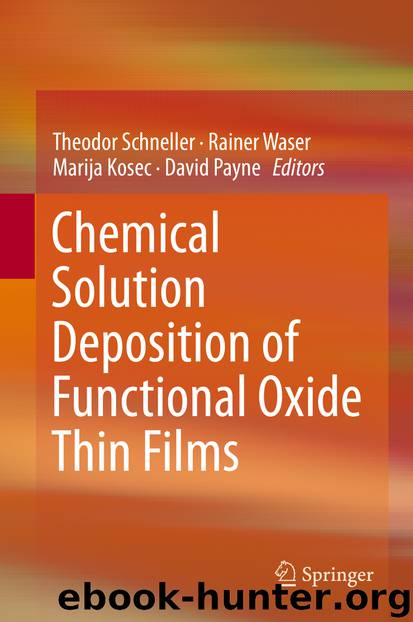Chemical Solution Deposition of Functional Oxide Thin Films by Theodor Schneller Rainer Waser Marija Kosec & David Payne

Author:Theodor Schneller, Rainer Waser, Marija Kosec & David Payne
Language: eng
Format: epub
Publisher: Springer Vienna, Vienna
For most film applications, the instability phenomenon is unwanted. For example, if the polycrystalline film were to be used as an electrode, its break-up into isolated islands would prohibit in-plane connectivity and thus, conductivity. On the other hand, the break-up into isolated, highly oriented single crystal islands can be used for a variety of applications. In one, if the single crystal islands are truly epitaxial, with a single orientational relation with the substrate both in-plane and out of plane, they can be used to produce ‘seeds’ to grow another material as a thin film. This was first accomplished by Kim and Lange [49] when it was found that the lattice mismatch between the PbTiO3 and LaAlO3, two perovskites, was too large to produce an epitaxial film without many defects. To reduce the defects, a very thin polycrystalline film of PbTiO3 was produced and heat treated to break-up the film into oriented single crystal islands on the LaAlO3 substrate. A second coating of the PbTiO3 precursor was then applied to the substrate containing oriented islands. After a second heat treatment, the large oriented islands consumed the very small grains within the film to produce a single crystal film with fewer defects. In another application of this ‘seeding’ method, ‘seeds’ of ZrO2 were produced on a basal plane sapphire substrate, where all grains had a single out-of-plane orientation, but due to the threefold symmetry axis of the underlying substrate, the cubic ZrO2 seeds had three in-plane variants, each related to one another by 120° [50]. In a third example [31], because of the large lattice mismatch (~9 %) between LiNbO3, which has an ‘α-alumina like’ structure, and a basal-plane alumina substrate, a poly-variant LiNbO3 forms. To avoid this, it was discovered that a single variant film could be produced using a two-step process. Namely, the first step produced a single variant at a lower temperature, whereas recoating produced an epitaxial film with the single variant [31]. One might comment on the La3TaO7 (LTO) seed layer reported by Bhuiyan et al. [51] discussed above. The published micrographs suggest that the isolated ‘seeds’ act in the same way as discussed for the last three examples. Namely, isolated LTO single crystal islands, produced by the grain growth phenomenon sited above, were the ‘seeds’ for the growth of the La2Zr2O7 (LZO) buffer layer, which is one part of the layered architecture of the superconductor wire. One more example can be given where lead titanate nano islands were produced by breaking up a film produced by the CSD method on a polycrystalline Pt substrate [52].
A second type of morphological instability, which causes a single crystal film to uncover the substrate, was recently discovered [53] when very thin, single crystal PbTiO3 films were grown on a SrTiO3. This instability is observed when the surface of a hole has a lower specific energy than the surface of the film. Experimental observations showed that three different film-configurations may exist, which depends on the film thickness: thick films completely cover the
Download
This site does not store any files on its server. We only index and link to content provided by other sites. Please contact the content providers to delete copyright contents if any and email us, we'll remove relevant links or contents immediately.
| Concrete | Extraction & Processing |
| Fracture Mechanics | Materials Science |
| Metallurgy | Polymers & Textiles |
| Strength of Materials | Testing |
Whiskies Galore by Ian Buxton(41866)
Introduction to Aircraft Design (Cambridge Aerospace Series) by John P. Fielding(33064)
Small Unmanned Fixed-wing Aircraft Design by Andrew J. Keane Andras Sobester James P. Scanlan & András Sóbester & James P. Scanlan(32743)
Craft Beer for the Homebrewer by Michael Agnew(18140)
Turbulence by E. J. Noyes(7935)
The Complete Stick Figure Physics Tutorials by Allen Sarah(7307)
Kaplan MCAT General Chemistry Review by Kaplan(6866)
The Thirst by Nesbo Jo(6826)
Bad Blood by John Carreyrou(6543)
Modelling of Convective Heat and Mass Transfer in Rotating Flows by Igor V. Shevchuk(6391)
Learning SQL by Alan Beaulieu(6208)
Weapons of Math Destruction by Cathy O'Neil(6139)
Man-made Catastrophes and Risk Information Concealment by Dmitry Chernov & Didier Sornette(5921)
Digital Minimalism by Cal Newport;(5661)
Life 3.0: Being Human in the Age of Artificial Intelligence by Tegmark Max(5474)
iGen by Jean M. Twenge(5366)
Secrets of Antigravity Propulsion: Tesla, UFOs, and Classified Aerospace Technology by Ph.D. Paul A. Laviolette(5309)
Design of Trajectory Optimization Approach for Space Maneuver Vehicle Skip Entry Problems by Runqi Chai & Al Savvaris & Antonios Tsourdos & Senchun Chai(5011)
Electronic Devices & Circuits by Jacob Millman & Christos C. Halkias(4907)
